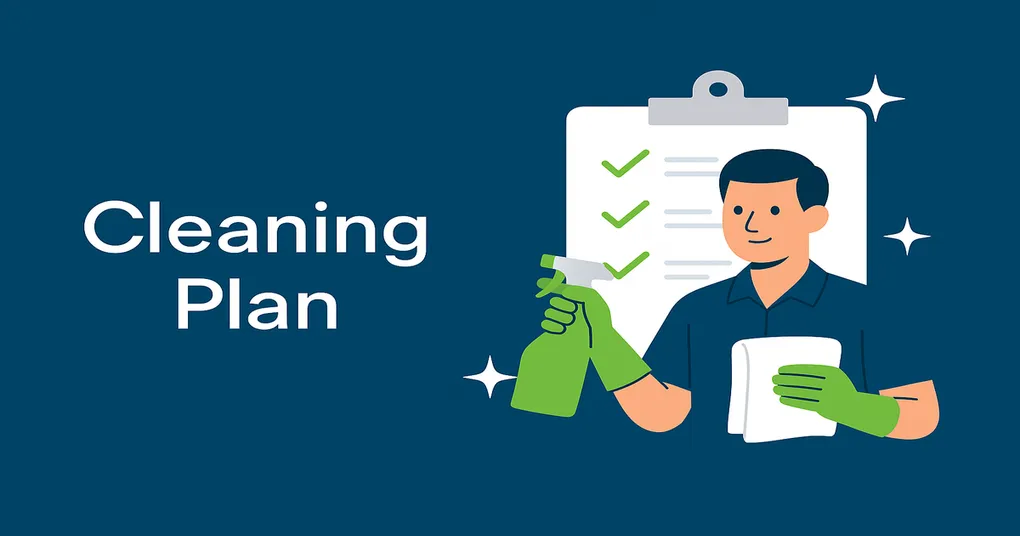
Achieving top-notch cleaning in aged care isn’t easy. With complex environments, a mix of stakeholders, and strict standards, you need a strategic, actionable approach. This article lays out a 30-day cleaning plan specifically for Facility Managers, Residential Services Managers, Quality Managers, and Hospitality Managers who want to see real improvements in hygiene and efficiency.
Drawing from the best in the business with down-to-earth examples, this guide walks you through setting things up, testing ideas, rolling out procedures, and using reports and audits to keep things on track. Here’s how you can lead this change confidently.
Week 1: Set Up Your Site and Tasks
The first step in a cleaning excellence plan is setting up your site and creating a task library. This week, take a close look at how your facility currently handles cleaning, then build a thorough catalog of tasks that fit your needs and standards.
Site Assessment
Start with a detailed walkthrough: spot cleaning hotspots, compliance gaps, and special attention areas like high-touch surfaces and resident rooms. Work with guidelines from health authorities and respected cleaning leaders like Asepsis.
Document everything—cleaning frequencies, responsible staff, methods used. Identify inefficiencies and areas that need standardization.
Build Your Task Library
Make a detailed list of every cleaning task necessary—from disinfecting common areas to waste management. Include clear instructions for each task, the cleaning agents needed, frequency, and responsible personnel.
For example, specify that high-touch areas in lounges must be cleaned twice daily with hospital-grade disinfectants. Add visual aids and checklists for guidance.
This library simplifies training, boosts task accountability, and supports audits. Consider digital tools for task management and data tracking, making rollouts and real-time changes easier.
Week 2: Test in a Pilot Wing
Week 2 is about bringing your plan to life in a specific wing and creating rules for addressing issues quickly.
Test the Plan
Choose a manageable wing or area for your initial test. This limits disruption while you refine procedures, train staff, and optimize workflows.
Monitor closely how well tasks are completed. Use both observation and digital reports to find bottlenecks and gather staff feedback on challenges.
Facilities often see compliance improve by nearly 20% after a controlled test like this. One aged care home saw greater staff confidence and fewer missed tasks following their trial.
Set Escalation Rules
Clear rules are vital to maintaining standards. Define who reports deviations, who gets notified, and what corrective steps follow.
For instance, if a task is missed twice, an alert goes out to the Quality Manager, who steps in with corrective training.
Link these rules with your reporting system for transparency and accountability. They also help reduce infection risks by ensuring timely attention to issues.
Week 3: Expand Across the Facility
After a successful test, week 3 involves rolling out your plan facility-wide. Strong leadership, clear communication, and ongoing staff engagement are crucial.
Train and Communicate
Train all cleaning and supervisory staff on new protocols using insights from your test. Training covers:
- Cleaning details
- Digital tool use
- Escalation rules
- Importance of compliance and quality
Use different formats—in-person, videos, posters. Show how cleaning excellence boosts resident safety and facility reputation.
Execute the Rollout
Roll out in phases if needed, starting in high-risk or high-traffic areas. Daily briefings help review goals, clarify questions, and address concerns.
Conduct spot checks and audits to verify task and policy adherence.
Expect new challenges. An aged care facility experienced longer cleaning times initially but saw audit score improvements within a week.
Week 4: Reporting and Audits
The last week focuses on setting up consistent reporting and audit practices to sustain success.
Regular Reports
Create daily and weekly reports on task completion, escalations, and audit findings. These reports help identify trends and risks early.
For example, a weekly report might show:
- Task completion rates
- Escalation numbers and types
- Audit scores by area
Develop an Audit Pack
Create standardized audit tools like checklists and scoring templates for Quality Managers and auditors to maintain effectiveness and performance reviews.
Include objective metrics, such as surface testing or visual scores. Use audits to guide training, resource allocation, or process changes. Top facilities audit monthly but adjust based on risk factors.
Measuring Success
Measure success with clear metrics and regular reviews. Set SMART goals that fit operational and regulatory needs.
Success indicators include:
- Over 95% task compliance
- Fewer cleaning-related issues or infections
- Better satisfaction scores
- Timely task completion and escalation handling
- Consistently hitting or exceeding audit scores
Hold biweekly or monthly check-ins with management to review progress and address issues. Celebrating wins keeps up momentum.
After implementing this plan, one facility cut outbreak incidents by 30% in three months.
Wrapping Up
A thoughtfully executed 30-day cleaning plan can elevate hygiene and safety while empowering your team. By building a solid foundation, piloting, rolling out in phases, and maintaining consistent reports and audits, you’ll see real improvements. Success hinges on clear communication, engaging staff, and using data effectively—this plan makes it possible.
Facility managers, take charge and bring clarity and confidence to your operations with this approach. For more insights and resources, visit Asepsis.
Start moving towards cleaning excellence today. Review your current protocols and work with your team on a tailored task library. With careful planning and steady execution, your 30-day strategy will create safer, cleaner spaces for everyone relying on you.